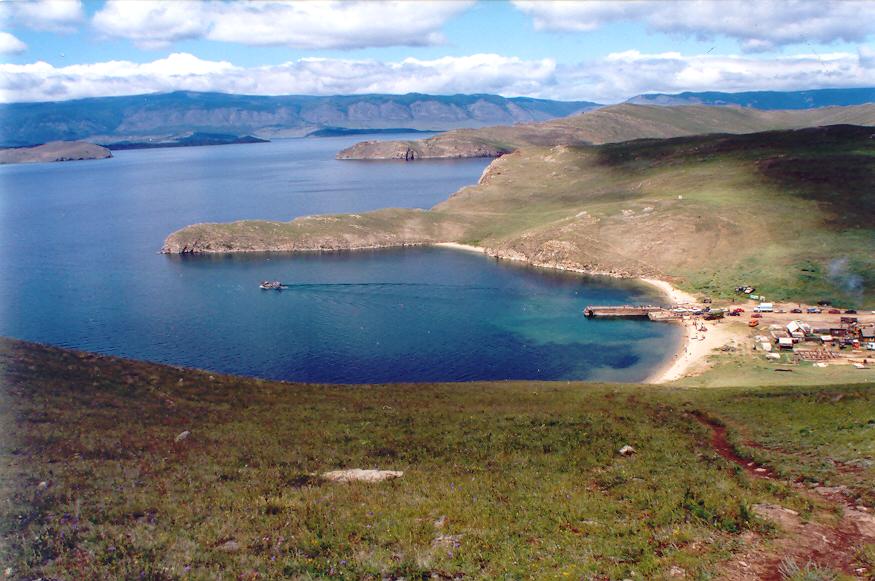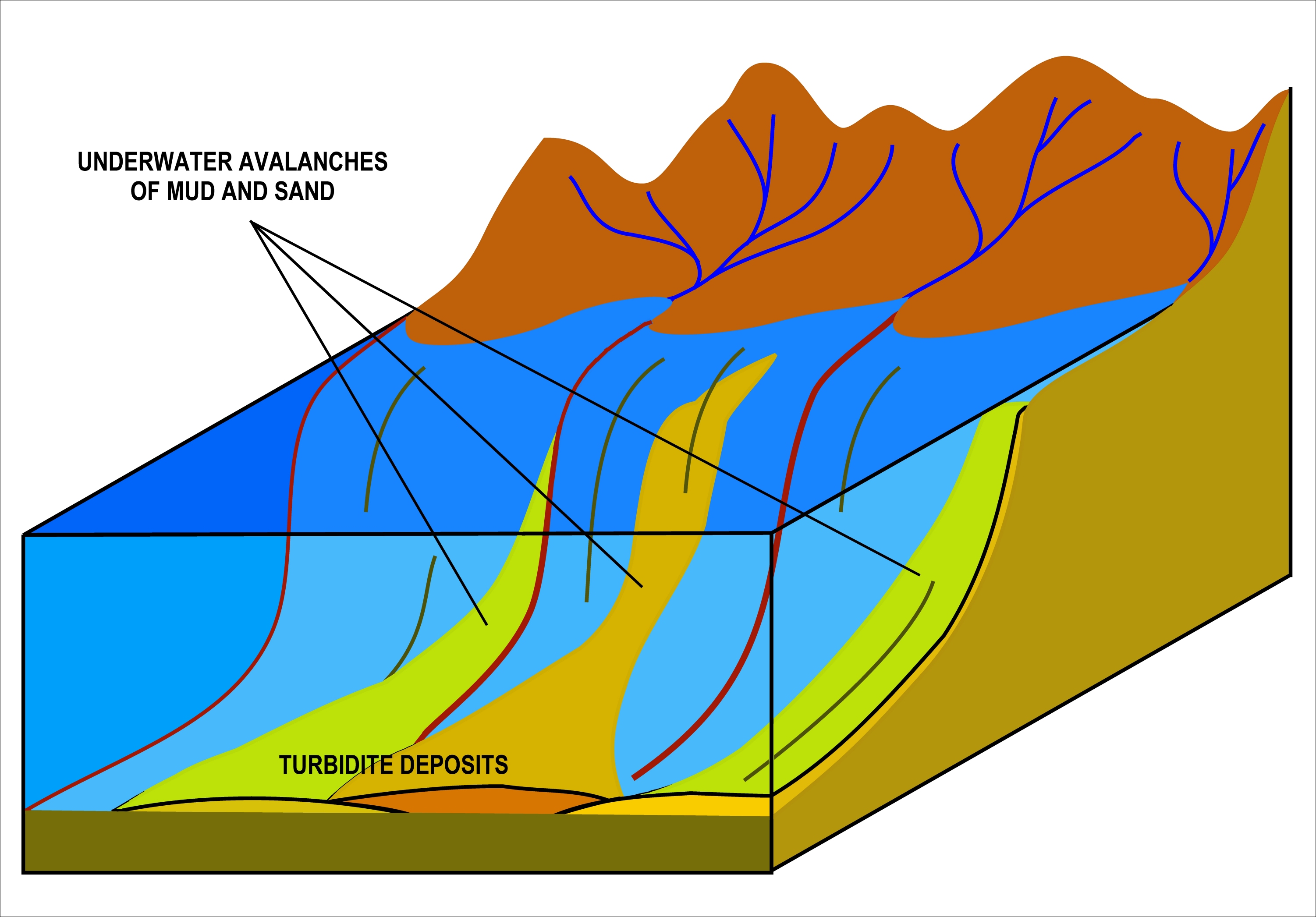|
Academician Ridge
Academician Ridge is an underwater, structural high separating two of Lake Baikal's three basins, the Central and North basins. Situated in the central part of the Baikal Rift, it serves as an "accommodation zone", transferring "motion between faults of similar displacement but different orientation" (Hutchinson et al., 1992). The ridge is bounded by two large normal faults, the Primorsky Fault on the northwest and the Olkhon Fault on the southeast, and an oblique-slip fault, the Academician Fault, that runs along the crest of the ridge. The margins of the ridge, Olkhon Island to the southwest and the Ushkanie Islands to the northeast, are above lake level while the center of the ridge is submerged to depths of 350–400 m (Kuzmin et al., 2000). Academician Ridge represents a unique sedimentary environment within Lake Baikal. The depths of the two basins it separates, about 900 m in the North Basin and about 1600 m deep in the Central basin, isolate the ridge from mass-flows and ... [...More Info...] [...Related Items...] OR: [Wikipedia] [Google] [Baidu] |
Lake Baikal
Lake Baikal (, russian: Oзеро Байкал, Ozero Baykal ); mn, Байгал нуур, Baigal nuur) is a rift lake in Russia. It is situated in southern Siberia, between the federal subjects of Irkutsk Oblast to the northwest and the Republic of Buryatia to the southeast. With of water, Lake Baikal is the world's largest freshwater lake by volume, containing 22–23% of the world's fresh surface water, more than all of the North American Great Lakes combined. It is also the world's deepest lake, with a maximum depth of , and the world's oldest lake, at 25–30 million years. At —slightly larger than Belgium—Lake Baikal is the world's seventh-largest lake by surface area. It is among the world's clearest lakes. Lake Baikal is home to thousands of species of plants and animals, many of them endemic to the region. It is also home to Buryat tribes, who raise goats, camels, cattle, sheep, and horses on the eastern side of the lake, where the mean temperature var ... [...More Info...] [...Related Items...] OR: [Wikipedia] [Google] [Baidu] |
Olkhon Island
Olkhon ( rus, Ольхо́н, also transliterated as Olchon; bua, Ойхон, ''Oikhon'') is the third-largest lake island in the world. It is by far the largest island in Lake Baikal in eastern Siberia, with an area of . Structurally, it constitutes the southwestern margin of the Academician Ridge. The island measures in length and in width. There are two versions regarding the origin of the name of the island and both are derived from the language of the Buryats, the indigenous people of Olkhon. The first is that the island's name comes from the word ''oyhon'' – “woody”, and the second is that it comes from ''olhan'' – “dry”. It is still debated which of the two is the actual origin of the name Olkhon as both words describe the island perfectly. Much of the island is still covered by forests and the amount of precipitation is extremely low – about per year. Geography Olkhon has a dramatic combination of terrain and is rich in archaeological landmarks. S ... [...More Info...] [...Related Items...] OR: [Wikipedia] [Google] [Baidu] |
Ushkany Islands
The Ushkan Islands (Russian — ''Ушканьи острова'' or ''Ushkanji Ostrova'') are a small archipelago on Lake Baikal in Russia. The group of islands consists of four islands: * One large island — ''Big Ushkan Island'', 9.5 km² or 3.7 sq mi. * Three islets: ''Long Ushkan Islet'' (1.25 km length), ''Thin Ushkan Islet'' (17 m height from Baikal's surface), and ''Round Ushkan Islet''. The islands are mainly composed of ancient (pre-Cambrian) crystallic limestone, and covered with larch forest. Islands' coastlines are rookery places of Baikal seals. A part of Transbaikal National Park, the Ushkan Islands are becoming a popular tourist Tourism is travel for pleasure or business; also the theory and practice of touring, the business of attracting, accommodating, and entertaining tourists, and the business of operating tours. The World Tourism Organization defines tourism mo ... destination. Nevertheless, special permission is required f ... [...More Info...] [...Related Items...] OR: [Wikipedia] [Google] [Baidu] |
Depositional Environment
In geology, depositional environment or sedimentary environment describes the combination of physical, chemical, and biological processes associated with the deposition of a particular type of sediment and, therefore, the rock types that will be formed after lithification, if the sediment is preserved in the rock record. In most cases, the environments associated with particular rock types or associations of rock types can be matched to existing analogues. However, the further back in geological time sediments were deposited, the more likely that direct modern analogues are not available (e.g. banded iron formations). Types of depositional environments Continental * – type of Fluvial deposit. Caused by moving water in a fan shape (Alluvial Fan) and containing mostly impermeable and nonporous sediments well sorted. * . Often in deserts and coastal regions and well sorted, large scale cross-beds * – processes due to moving water, mainly streams. Common sediments are grav ... [...More Info...] [...Related Items...] OR: [Wikipedia] [Google] [Baidu] |
Turbidites
A turbidite is the geologic deposit of a turbidity current, which is a type of amalgamation of fluidal and sediment gravity flow responsible for distributing vast amounts of clastic sediment into the deep ocean. Sequencing Turbidites were first properly described by Arnold H. Bouma (1962), who studied deepwater sediments and recognized particular "fining-up intervals" within deep water, fine-grained shales, which were anomalous because they started at pebble conglomerates and terminated in shales. This was anomalous because within the deep ocean it had historically been assumed that there was no mechanism by which tractional flow could carry and deposit coarse-grained sediments into the abyssal depths. Bouma cycles begin with an erosional contact of a coarse lower bed of pebble to granule conglomerate in a sandy matrix, and grade up through coarse then medium plane parallel sandstone; through cross-bedded sandstone; rippled cross-bedded sand/silty sand, and finally lamina ... [...More Info...] [...Related Items...] OR: [Wikipedia] [Google] [Baidu] |
Hemipelagic
Hemipelagic sediment, or hemipelagite, is a type of marine sediment that consists of clay and silt-sized grains that are terrigenous and some biogenic material derived from the landmass nearest the deposits or from organisms living in the water. Hemipelagic sediments are deposited on continental shelves and continental rises, and differ from pelagic sediment compositionally. Pelagic sediment is composed of primarily biogenic material from organisms living in the water column or on the seafloor and contains little to no terrigenous material. Terrigenous material includes minerals from the lithosphere like feldspar or quartz. Volcanism on land, wind blown sediments as well as particulates discharged from rivers can contribute to Hemipelagic deposits. These deposits can be used to qualify climatic changes and identify changes in sediment provenances. Deposition Hemipelagic sediment dispersal is mainly controlled by fluvial discharge. Dispersal rate is influenced by sea-level variatio ... [...More Info...] [...Related Items...] OR: [Wikipedia] [Google] [Baidu] |
Ice Rafting
Ice rafting is the transport of various materials by ice. Various objects deposited on ice may eventually become embedded in the ice. When the ice melts after a certain amount of drifting, these objects are deposited onto the bottom of the water body, e.g., onto a river bed or an ocean floor. These deposits are called ice rafted debris (IRD) or ice rafted deposits. Ice rafting was a primary mechanism of sediment transport during glacial episodes of the Pleistocene when sea levels were very low and much of the land was covered by large masses (sheets) of ice. The rafting of various size sediments into deeper ocean waters by icebergs became a rather important process. Ice rafting is still a process occurring today, although its impact is significantly less and much harder to gauge. The melting of large icebergs deposits sediment of various sizes, usually referred to as glacial marine sediment, onto the shelf and deeper marine areas. Ice rafting may be used for analysis of ice drif ... [...More Info...] [...Related Items...] OR: [Wikipedia] [Google] [Baidu] |
Lake
A lake is an area filled with water, localized in a basin, surrounded by land, and distinct from any river or other outlet that serves to feed or drain the lake. Lakes lie on land and are not part of the ocean, although, like the much larger oceans, they do form part of the Earth's water cycle. Lakes are distinct from lagoons, which are generally coastal parts of the ocean. Lakes are typically larger and deeper than ponds, which also lie on land, though there are no official or scientific definitions. Lakes can be contrasted with rivers or streams, which usually flow in a channel on land. Most lakes are fed and drained by rivers and streams. Natural lakes are generally found in mountainous areas, rift zones, and areas with ongoing glaciation. Other lakes are found in endorheic basins or along the courses of mature rivers, where a river channel has widened into a basin. Some parts of the world have many lakes formed by the chaotic drainage patterns left over from the la ... [...More Info...] [...Related Items...] OR: [Wikipedia] [Google] [Baidu] |
Landforms Of Siberia
A landform is a natural or anthropogenic land feature on the solid surface of the Earth or other planetary body. Landforms together make up a given terrain, and their arrangement in the landscape is known as topography. Landforms include hills, mountains, canyons, and valleys, as well as shoreline features such as bays, peninsulas, and seas, including submerged features such as mid-ocean ridges, volcanoes, and the great ocean basins. Physical characteristics Landforms are categorized by characteristic physical attributes such as elevation, slope, orientation, stratification, rock exposure and soil type. Gross physical features or landforms include intuitive elements such as berms, mounds, hills, ridges, cliffs, valleys, rivers, peninsulas, volcanoes, and numerous other structural and size-scaled (e.g. ponds vs. lakes, hills vs. mountains) elements including various kinds of inland and oceanic waterbodies and sub-surface features. Mountains, hills, plateaux, and plains are the fo ... [...More Info...] [...Related Items...] OR: [Wikipedia] [Google] [Baidu] |
Sedimentology
Sedimentology encompasses the study of modern sediments such as sand, silt, and clay, and the processes that result in their formation (erosion and weathering), transport, deposition and diagenesis. Sedimentologists apply their understanding of modern processes to interpret geologic history through observations of sedimentary rocks and sedimentary structures. Sedimentary rocks cover up to 75% of the Earth's surface, record much of the Earth's history, and harbor the fossil record. Sedimentology is closely linked to stratigraphy, the study of the physical and temporal relationships between rock layers or strata. The premise that the processes affecting the earth today are the same as in the past is the basis for determining how sedimentary features in the rock record were formed. By comparing similar features today to features in the rock record—for example, by comparing modern sand dunes to dunes preserved in ancient aeolian sandstones—geologists reconstruct past environmen ... [...More Info...] [...Related Items...] OR: [Wikipedia] [Google] [Baidu] |





.jpg)